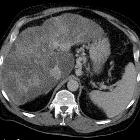hepatofugal

Budd-Chiari
Syndrome in a Patient with Chronic Alcoholic Cirrhosis. US of the liver shows hepatofugal flow in the portal vein, which is indicative of continuous flow with reduced velocity. This a sign that can be visualized in the acute phase of budd chiari syndrome.

Hepatofugal
• Hepatofugal portal venous flow - Ganzer Fall bei Radiopaedia

Budd-Chiari
Syndrome in a Patient with Chronic Alcoholic Cirrhosis. Hepatofugal flow in portal vein is demonstrated on these colour Doppler images of the abdomen.

Hepatofugal
flow in portal vein in ultrasound - patient has known cirrhosis
Hepatofugal or non-forward portal flow (NFPF) is an abnormal flow pattern in which the portal venous flow is from the periphery of the liver towards the porta and backwards along the portal vein. This phenomenon is not uncommon in patients with liver disease .
It is the opposite of hepatopetal.
Hepatofugal flow can be demonstrated on angiography, Doppler ultrasonography, magnetic resonance imaging, and/or CT. Doppler ultrasound however tends to be the best modality at quantifying this abnormality.
Pathology
Causes
- cirrhosis with portal hypertension
- considered the most common cause of hepatofugal flow in the portal venous system
- usually tends to be continuous reversal rather than pulsatile reversal
- indicates advanced portal hypertension
- cirrhotic patients with hepatofugal flow are thought to have greater hepatic dysfunction, a higher incidence of hepatic encephalopathy, variceal bleeding and higher mortality compared with cirrhotic patients with hepatopetal flow
- can change back to hepatopetal flow after ingestion of food, which is considered to on the basis of a postprandial increase in splanchnic venous flow and portal venous flow, this phenomenon however may be blunted in patients with cirrhosis
- Budd-Chiari syndrome
- tricuspid regurgitation: tends to have reversed pulsatile flow (RPF) in portal vein.
- arterioportal fistula in liver
- post liver transplantation
History and etymology
The term hepatofugal derives from the Ancient Greek 'hepar' meaning 'liver' and Latin 'fugare' meaning 'to flee' referring to the direction of flow away from the liver.
See also
Siehe auch:

 Assoziationen und Differentialdiagnosen zu hepatofugaler Fluss in der Vena portae:
Assoziationen und Differentialdiagnosen zu hepatofugaler Fluss in der Vena portae:




